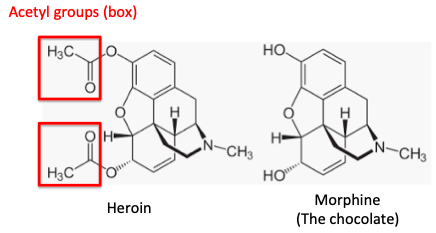Heroin, not oxycodone or hydrocodone, is by far the most dangerous opiate on the street. But technically, it isn't dangerous at all. And it's not necessarily a "street" drug because It can be legal. Confused? Read on, because here's a bunch of stuff you might not know about heroin.
- Heroin is like a box of chocolates

Heroin is a pro-drug of morphine. (A pro-drug is a pharmacologically-inactive form of a drug that is converted by the body to the active species.) Your opioid receptors don't like those two acetyl groups (red squares) very much, so if you could magically transport heroin into the brain and it remained metabolically stable (1) heroin would probably be a word you've never heard. Put in a more palatable way, the acetyl "boxes" (2) keep the brain from tasting the chocolate, just like an Amazon box doesn't taste like chocolate until it's opened. So, at the risk of being pedantic, it is strictly accurate to say that heroin itself is harmless. But, there are metabolizing enzymes in the blood and brain that open that box really fast and your brain gets a whole big dose of chocolate morphine at once. This is why injection is the preferred route of administration. Heroin can be taken orally but this "defeats its purpose." From the gut, it passes through the portal vein on its way to the liver, where it rapidly gets turned into morphine. But now the morphine will get to your brain slowly, hence, no rush.

Original photo: Flickr
2. Heroin is legal in some places, but not in the US.
In the US heroin is a Schedule I drug, meaning that it has no approved medical use and a high risk of abuse potential. Period. Other countries view things differently. Canada, Germany, Denmark, Norway, Belgium, and Holland, in different ways, practice risk reduction, and if that means giving heroin to heroin addicts so be it. It's a prescription analgesic in Britain, typically used for treating the pain from end-stage cancer. They always were more civilized over there.
3. Heroin is not a brown lump or a tar.
Like most organic compounds, heroin is a white solid with a melting point of 173oC (pretty typical). Any color is a result of impurities, however, a white powder sure doesn't indicate that you have 100% pure heroin on your hands (you never do). It just means that the heroin was cut with another white solid, like sugar, starch, baking soda, quinine... When heroin smells like vinegar it is because of lousy organic synthesis techniques. A chemical called acetic anhydride is used to convert morphine into heroin. Its byproduct is acetic acid (vinegar). Acetic anhydride also smells like vinegar. Plus a kick in the face from a mule. So, if you smell vinegar it means that one or both of these impurities is present (but they're cotton candy compared to some of the other crap found in there).
4. Heroin was first invented in 1874. In England.
Most people think that heroin was invented in Germany, but that's wrong. A chap named C. R. Wright at St. Mary's Hospital in London first made the stuff from morphine and acetic anhydride and published the synthesis:
Wright, C. R. A.: "On the action of organic acids and their anhydrides on the natural alkaloids," Journal of Chemical Society, 1874, 12, 1031.
It wasn't until 1898 that it was first marketed by Bayer, ironically, as a "less addictive" form of morphine. That didn't work out so well:
Prettey, G. E.: The heroin habit another curse, Alabama Medical Journal, 1902-03, 15, 174-180.
Ironically, in 1899 Bayer started selling aspirin. It is now 121 years later and our mainstays of pain control are pretty much the same – NSAIDs and opioids.
5. Heroin is an opiate and an opioid. It's also synthetic but comes from something natural. Duh.
I've written before about the stupid and arbitrary nomenclature used for narcotics. Basically, anything that hits an opioid receptor is an opioid. But if the drug is found in poppy it's an opiate because it's "natural." But heroin is found nowhere on earth; it's a synthetic derivative of morphine (a naturally occurring opiate), which makes it a synthetic (also called semi-synthetic) opiate. And an opioid (3). Arrgh. Have you had enough?
I'm guessing yes because I sure have. Writing this has been exhausting. Maybe the guy on the bench will share his chocolates.
NOTES:
(1) The physiological response to heroin is not to the drug itself, but to its metabolites, morphine, and 6-monoacetylmorphine.
(2) The "box" has another function. Hydroxyl groups (OH) make a molecule more hydrophilic (water-loving) and chemicals of this type have a more difficult time reaching the brain. When the hydroxyl groups are masked by acetyl groups the resulting drug (heroin) is more lipophilic (fat-loving) and gets into the brain more easily. Then the acetyl groups are knocked off and boom!



